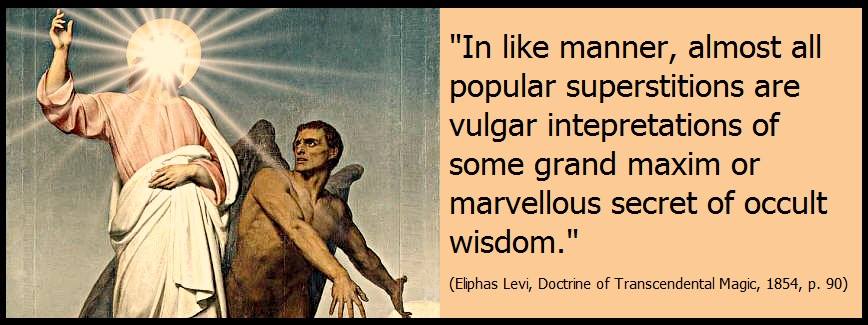Page 253
“Think not my magic wonders wrought by aid
Of Stygian angels summoned up from Hell;
Scorned and accursed by those who have essay’d
Her gloomy Divs and Afrites to compel.
But by perception of the secret powers
Of mineral springs, in nature’s inmost cell,
Of herbs in curtain of her greenest bowers,
And of the moving stars o’er mountain tops and towers.” — TASSO, Canto XIV., xliii.
“Who dares think one thing and another tell
My heart detests him as the gates of Hell!” — POPE.
“If man ceases to exist when he disappears in the grave, you must be compelled to affirm
that he is the only creature in existence whom nature or providence has condescended to
deceive and cheat by capacities for which there are no available objects.” — BULWER-
LYTTON: Strange Story. THE preface of Richard A. Proctor’s latest work on astronomy, entitled Our Place among Infinities, contains the following extraordinary words: “It was their ignorance of the earth’s place among infinities, which led the ancients to regard the heavenly bodies as ruling favorably or adversely the fates of men and nations, and to dedicate the days in sets of seven to the seven planets of their astrological system.”
Mr. Proctor makes two distinct assertions in this sentence: 1. That the ancients were ignorant of the earth’s place among infinities; and 2. That they regarded the heavenly bodies as ruling, favorably or adversely, the fates of men and nations. We are very confident that there is at least good reason to suspect that the ancients were familiar with the movements, emplacement, and mutual relations of the heavenly bodies. The testimony of Plutarch, Professor Draper, and Jowett, are sufficiently explicit. But we would ask Mr. Proctor how it happens, if the ancient astronomers were so ignorant of the law of the birth and death of worlds that, in the fragmentary bits which the hand of time has spared us of ancient lore there should be — albeit couched in obscure language — so much information which the most recent discoveries of science have verified? Beginning with the tenth page of the work under notice, Mr. Proc-
Page 254
tor sketches for us the theory of the formation of our earth, and the successive changes through which it passed until it became habitable for man. In vivid colors he depicts the gradual accretion of cosmic matter into gaseous spheres surrounded with “a liquid non-permanent shell”; the condensation of both; the ultimate solidification of the external crust; the slow cooling of the mass; the chemical results following the action of intense heat upon the primitive earthy matter; the formation of soils and their distribution; the change in the constitution of the atmosphere; the appearance of vegetation and animal life; and, finally, the advent of man.
Now, let us turn to the oldest written records left us by the Chaldeans, the Hermetic Book of Numbers, and see what we shall find in the allegorical language of Hermes, Kadmus, or Thuti, the thrice great Trismegistus. “In the beginning of time the great invisible one had his holy hands full of celestial matter which he scattered throughout the infinity; and lo, behold! it became balls of fire and balls of clay; and they scattered like the moving metal into many smaller balls, and began their ceaseless turning; and some of them which were balls of fire became balls of clay; and the balls of clay became balls of fire; and the balls of fire were waiting their time to become balls of clay; and the others envied them and bided their time to become balls of pure divine fire.
” Could any one ask a clearer definition of the cosmic changes which Mr. Proctor so elegantly expounds?
Here we have the distribution of matter throughout space; then its concentration into the spherical form; the separation of smaller spheres from the greater ones; axial rotation; the gradual change of orbs from the incandescent to the earthy consistence; and, finally, the total loss of heat which marks their entrance into the stage of planetary death. The change of the balls of clay into balls of fire would be understood by materialists to indicate some such phenomenon as the sudden ignition of the star in Cassiopeia, A.D. 1572, and the one in Serpentarius, in 1604, which was noted by Kepler. But, do the Chaldeans evince in this expression a profounder philosophy than of our day? Does this change into balls of “pure divine fire” signify a continuous planetary existence,

Moe is the founder of GnosticWarrior.com. He is a father, husband, author, martial arts black belt, and an expert in Gnosticism, the occult, and esotericism.

![How one in the province of the Northumbrians, rose from the dead, and related many things which he had seen, some to be greatly dreaded and some to be desired [Circ. 696 A.D.] | Book 5 | Chapter 11 How one in the province of the Northumbrians, rose from the dead, and related many things which he had seen, some to be greatly dreaded and some to be desired [Circ. 696 A.D.] | Book 5 | Chapter 11](https://www.gnosticwarrior.com/wp-content/plugins/contextual-related-posts/default.png)




